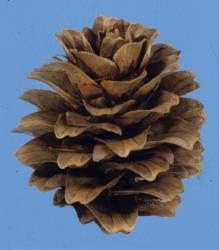- Taxon
- Weed
- Gallery
Small or medium-sized tree (large in cultivation), pyramidal when young, irregular in shape later. Branchlets ± drooping. Bark grey, pinkish below, fissured and forming small plates. Long shoots yellow, glabrous, appearing ribbed because of elongated, pad-like persistent lf bases. Short shoots stout, c. 5 mm long, grey. Lvs on short shoots in fascicles of 40–65, 1.5–4 cm × c. 0.5 mm at 1/2 way along lf, grass-green, very soft; midrib raised on either side. ♂ and ♀ strobili or cones surrounded by thin, brown bud scales with dense marginal tuft of curly brown hairs. ♀ cones c. 1 cm long at anthesis; bract scales prominent, crimson, with subulate, green apical point. Mature cone 1.5–3.5 × 1.7–2.5 cm when open, broadly ovoid-oblong; ovuliferous scales 40–50, broad-ovate or suborbicular, not prominently recurved, vertically striated with outer margin rounded; bract scales usually concealed at maturity, sometimes a small part of subulate tip exposed. Seed with large, broad, asymmetric wing.
[From: Webb et al. (1988) Flora of New Zealand. Volume 4.]




